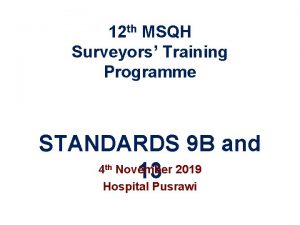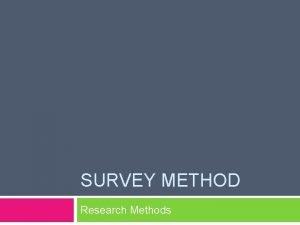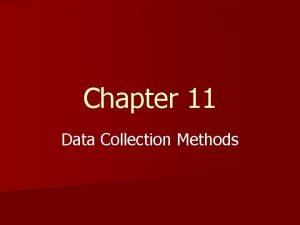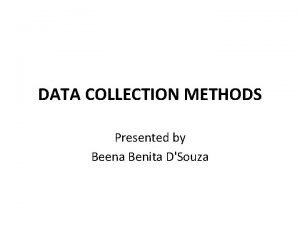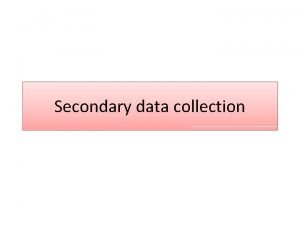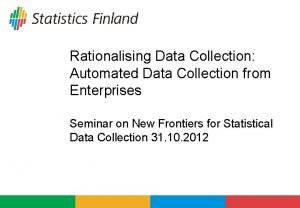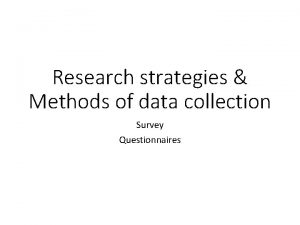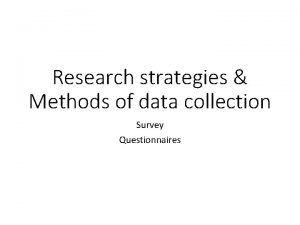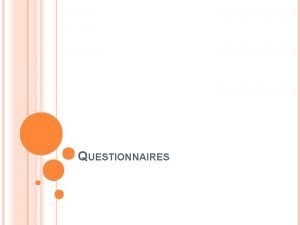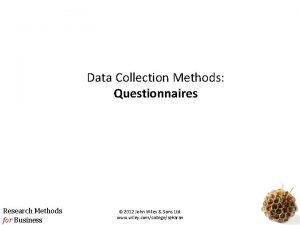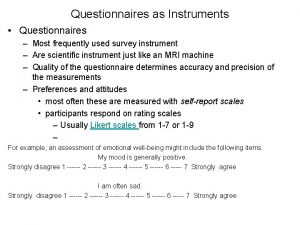Research strategies Methods of data collection Survey Questionnaires














- Slides: 14

Research strategies & Methods of data collection Survey Questionnaires

The survey strategy • Focuses on a given population (via sampling) • What, who, where, how much, how many? • Mostly exploratory, descriptive; but can also suggest models, relationships, possible reasons • Survey using questionnaires are popular: • • • can provide standardized, quantitative data from a sizeable population the per data (or per respondent) cost is very low allows easy comparison in general it is perceived as authoritative relatively easy to understand & explain

The survey strategy • Provides relatively strong control over the research process • Can provide representative results (is the sampling is adequate) • Pilot study is necessary • Allows inependent research (it is your data) • Primary data collection methods: • Questionnaires • Structured observations • Structured interviews

Questionnaires

Questionnaire • A method of data collection in which each respondent answers the same questions in a predetermined order.

Questionnaires • The use of questionnaires is overrepresented among data collection methods • Good for descriptive and explanatory (and not for exploratory) research • Works best with standardised questions (interpreted on the same way by all respondents) • Can be used as the only method, but works better in combination with qualitative techniques • Limitations: • Limited number of questions • Threat: creating a wrong one

Types of questionnaire Self-completed: • Internet questionnaires: • • on-line, off-line web, mobile available population? visual apperarnace can vary by screns • Postal questionnaires • Delivery and collected questionnaires Interviewer-completed: • Telephone questionnaires • Face-to-face questionnaires (= structured interviews? )

How to choose? • Characteristics of the prospective respondents • Importance of reashing a particular respondent • Importance of avoiding contamination and distortion • Size of sample needed • Types of question • Number of questions • Available resources (feasibility)

Improving response rates for postal questionnaires Incentives: monetary, sent with questionnaire Length: shorter Appearance: brown envelope, colored ink Delivery: recorded delivery, stamped return envelope Contact: pre-, follow-up Content: interesting/relevant, user friendly language, behavioral and demographic questions only (no attitude questions) • Origin: university sponsorship • Communication: explanation for not-participating requested, anonimity stressed • • •

Steps of questionnaire data collection • Concept of the research: definitions, population, research question etc. • Design • Pilot testing • Amendment • Sampling • Delivering • Coding • Entering (typing) • Preparation for analysis • Analysing

Types of items (individual questions) • Open: • Numbers • Text: • Words • Senteces • Longer text • Semi-closed • Eg. : closed + „other: …. ” • Closed

Types of closed questions • List questions: • Binary (eg. yes/no) • Select one • Select more • Category questions • Ranking questions • Rating questions (eg. Likert-scale): • • • Agreement Amount Frequency Likelihood Etc. • Semantic differential • Matrix questions

Combining items into one variable • Indices • Scales • Typologies

Consructing the questionnaire • Order of the questions • Visual presentation • Coering letter or welcome screen • Introduction text • Closing • Contacts
 Naep survey questionnaires
Naep survey questionnaires Msqh survey questionnaires
Msqh survey questionnaires Tools of legal research
Tools of legal research Survey method of data collection
Survey method of data collection Survey data collection
Survey data collection Types of data collection methods
Types of data collection methods Observational data collection method
Observational data collection method Data collection methods observation
Data collection methods observation What is a primary data
What is a primary data Automated data collection methods
Automated data collection methods Kuesioner terstruktur dan tidak terstruktur
Kuesioner terstruktur dan tidak terstruktur Picture-cued tasks
Picture-cued tasks Lecture automatique de questionnaires
Lecture automatique de questionnaires Type scale
Type scale Questionnaires about vaal river
Questionnaires about vaal river

